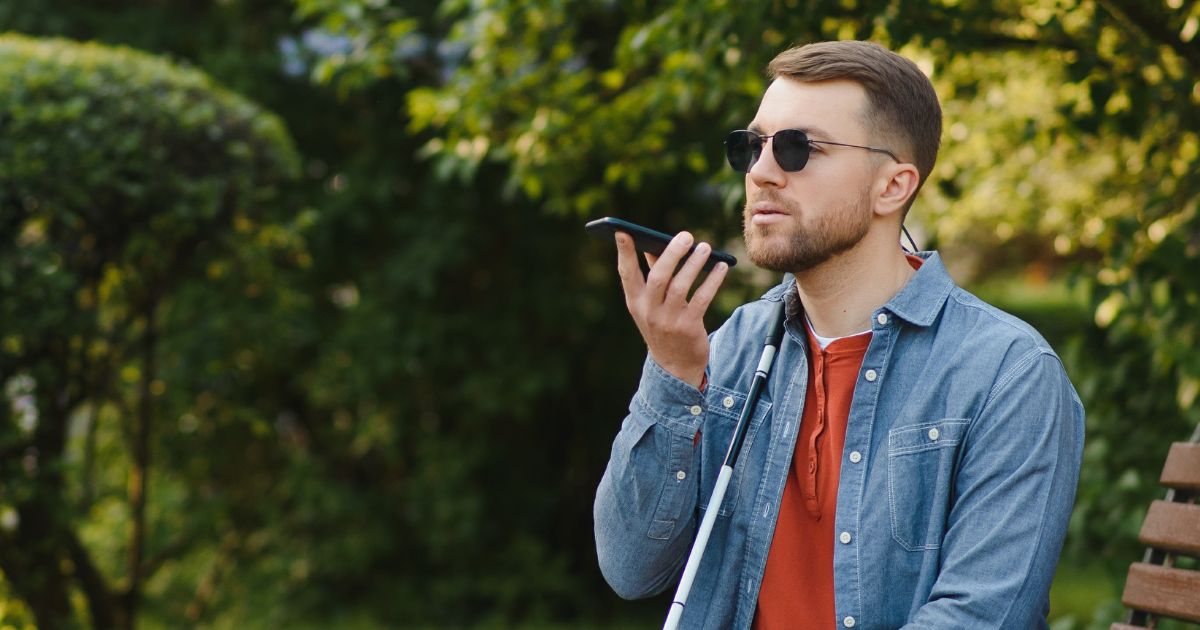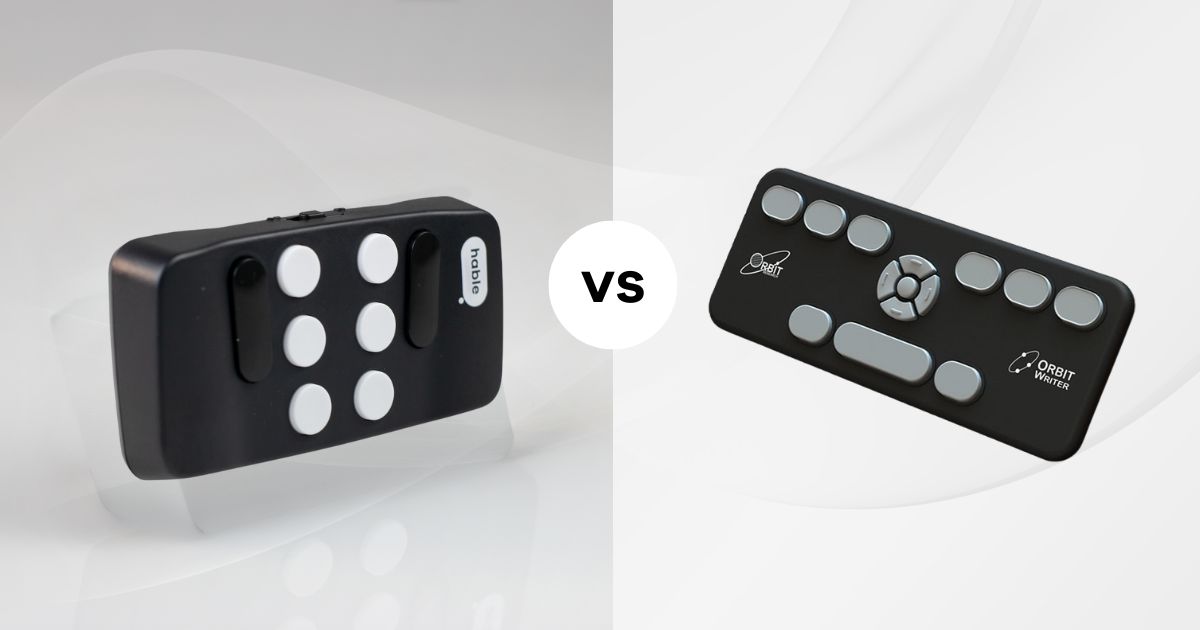Learning Braille: Why Every Person Who is Blind Should Consider It?

The Royal National Institute for Blind people states that only around 7% of people who are registered blind or visually impaired in the United Kingdom use braille. That means that 93% of this group does not use it! Braille is a great communication tool for people who are blind or visually impaired.
Learning how to use it could benefit them in multiple ways on a daily basis. Because we believe braille can improve quality of life, and because there are a lot of misconceptions, we dedicated this blog to the benefits of learning braille. We hope you get inspired!
What is braille?
Braille is a code designed to be read by the touch of your fingers. We wrote a detailed blog about Braille, what it is and how it works. The code consists of raised dots. These dots are arranged in two columns.
The different ways of placing these dots represent letters and numbers. There are two grades of braille. Uncontracted braille, also known as Grade 1, is braille written by using individual letters, numbers and punctuation marks.
Contracted braille, also known as Grade 2, uses contractions for combinations of letters or common words such as ‘ing’, ‘the’ and ‘for’. This reduces the length of documents and increases the speed in which braille users read.
Literacy
Being literate means the ability to read and write. Literacy is immensely important. Sighted people learn this from a very young age. They go to primary school and start learning letters, then sentences and eventually whole stories.
For people who are blind and visually impaired, this is not the case. For children who are born with a visual disability it is not mandatory to learn how to read and write. Which is insane if you think about it.

Reading vs. Listening
Studies show that reading, for the average adult, is faster than listening. The average adult reads about 250 to 300 words per minute. Whereas the recommended talking speed is 150 to 160 words per minute.
To put this into perspective, an auctioneer speaks around 250 words per minute. But nobody wants that. The average braille user reads 125 words per minute. This is slower than the talking speed but that doesn’t mean braille doesn’t have benefits over listening
Reading wins
Studies have shown that reading is a more effective way to receive, process and share information than audio. Daniel Willingham, a professor of psychology at the University of Virginia explains this theory.
About 10 to 15% of eye movements during reading are regressive. This means that the eyes are going back over the text you just read to check it again. You could also pause an audio book or go over the same part again but it doesn’t get done as often.
Another reason that reading is more effective are our wandering minds. It doesn’t matter if we read or listen, we zone out for a couple of seconds, or even minutes.
If you’re reading a printed book, it is not difficult to go back. If you are listening, you are more inclined to keep listening instead of going back. Therefore, you miss certain information.
Another aspect that benefits reading braille over listening to audio is being able to spell certain words. By listening instead of reading you would never know how to spell a name or place. Or know the difference between two names that are pronounced the same but spelled in a different way.
Additionally, to spelling, grammar is a big part of a language. Punctuation can be very tricky when using audible technology. Punctuation is not always used correctly, which in turn causes confusion when listening instead of reading.
Audible technology will just keep going as if there is not a comma or full stop. Reading it yourself can prevent this. You can know more about reading in Braille through this amazing article that brings a complete guide and explanation about it.
More job opportunities
Being able to use braille improves your chance of being employed. Literacy is an important factor for employment. The unemployment rate within the group of non-braille users is about 77% whereas it is 44% for braille users.
Being able to use braille increases your chances of being employed significantly. Braille is a fast and efficient way of communication and very useful when working with written documents such as manuals, reports or other files.
By combining your knowledge of braille along with assistive technology such as screen readers of braille keyboards, people who are blind or visually impaired are able to work successful in a wide range of jobs. You can know more about workplace accommodation for visually impaired people in this article.

Be more independent
Braille comes with a lot more independence for people who are blind and visually impaired. You are able to read and write without needing the help of a sighted person. This gives you more independence on a daily basis.
You are able to label certain products and items around your house. Things like the microwave, oven and refrigerator can be labelled. But also the spices in your kitchen or the drawers in your closet.
Beside labelling things, yourself, there are also other things that already use braille. A lot of public spaces such as elevators use braille. But also certain products like medicine can be read by braille users. These are all examples of braille being able to give you a more independent lifestyle.
Have more privacy
It does not only give you more independence. Using braille in your daily life also provides you with privacy. You don’t need sighted people to help you read and write which gives you the independence to keep certain parts of your life private.
Most banks and government organisations provide their documents in braille. Therefore, you don’t have to share this kind of information with anyone but yourself. Some items in the grocery store such as medicine are also often braille labelled.
Which means that you can go out and shop for it yourself instead of asking a friend or family member to do so.
Another part of privacy that you can get back when you use braille has to do with your smartphone. If you use technology such as Voiceover, you talk to your phone and tell it what to write or search. In this way, the people around you can eavesdrop.
Whereas with braille, you can use a braille keyboard and you no longer have this issue.
Being able to use braille technology
We currently live in a digital age. A lot of our time is spent online. We browse the internet, scroll through social media platforms and chat to friends and family. This online world has not been the friendliest place for people that are blind or visually impaired, accessibility wise. However, times are changing and technology keeps improving.
We now have easy access to audiobooks and podcasts. Giving people who are blind or visually impaired more ways to consume their information. But digital technology still falls short in writing.
The speech-to-text software such as Apple’s Voiceover enables you to speak and they convert your words. However, this is not ideal and comes with its difficulties. The transcription software can fail converting correctly.
For example, when people have a thick accent or are not articulate enough. Assistive technology that uses braille helps you with this problem.
- It gives you more privacy when there are others around
- Speech-to-text software is not foolproof
- You are independent to write texts yourself
Learning Braille with the Hable One
One great way of learning Braille is by using the Hable One. If you are new to Braille and it seems quite daunting to you, using the Hable One might just be the best way to get started. As you only have to type in Braille on the Hable One this is a lot easier.
We go more in depth about this in this blog. The Hable One is a small portable braille keyboard that allows you to control the entire phone and enter text using Braille. With direct auditory feedback, your learning pace will skyrocket!
If you are interested in what the Hable One can do for you, find more information here.

Challenges of Braille
Now, let’s be honest here. There are also many challenges with Braille. Reading Braille takes time to master. Consistent learning is required and it won’t always be fun.
In these other blogs about learning to read Braille or learning to Write Braille, we go in detail about the challenges that come with learning Braille. But more importantly, we investigate how you can overcome these challenges!
In conclusion, there are many reasons why you should consider learning Braille. As they say, don’t judge a book by its cover. We recommend you try Braille and only decide if it’s a ‘no’ afterwards. Now you certainly won’t regret it at a later stage! If you liked this article, don't forget to share it and I wait you in the next blog!



Order Hable One today and experience the difference.





